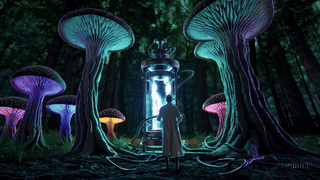LET’S SEE WHERE THIS FUNGALLY-CHARGED ROCKET SHIP TAKES US
There’s a strange, electric hum in the underground labs of sustainability—an outlandish vibe that I can only describe as the birth-cry of a new ecological revolution. It’s an unholy union of mushrooms and bio-based resins, congealing to form materials that might just save us from our own plastic-littered future. The technique is called Bio-Resin Infusion for Mycelium Composites, and it’s got everything: vacuum chambers, organic matter, and a dash of riotous, fungal wizardry.
Here we are, balancing precariously on the tip of some bizarre ecological surfboard—riding the wave of mycelium-bound composites, injecting these mushroom-based structures with natural resins that bolster flexibility, enhance durability, and keep the entire shebang biodegradable. It’s the kind of science that roars with the laughter of the weird and the wonderful, promising mechanical and thermal properties that conventional synthetics can only dream about.
THE RISE OF MYCELIUM COMPOSITES
First, let’s get one thing straight: Mycelium is the root-like network of fungi—think of it as the Internet of the mushroom world. You might have seen mushrooms sprouting in the backyard at three in the morning after a hard rain. Those are merely the fruiting bodies. Below ground, the mycelium is a tangled, relentless tapestry of life, recycling dead matter back into the ecosystem.
Now, some brilliant maniacs in labs across the globe decided to harness that unstoppable growth engine. They feed agricultural byproducts—like sawdust, straw, hemp hurd—to the mycelium. In response, the fungi’s filaments create a dense mesh, binding everything together into a cohesive, foam-like mass. Dry it, shape it, and voilà: you’ve got the makings of a biodegradable composite. Kiss your styrofoam goodbye, because we’re stepping into a greener dimension.
THE VACUUM INFUSION TWIST
But we live in a world that demands performance. Fungi alone can’t always handle the big, bad industrial environment. Enter the vacuum infusion technique—a method once reserved for building sleek boats and Formula 1 race cars. Instead of synthetic resins, the experimenters here are going all in with bio-resins—naturally derived, renewable, and downright rebellious compared to their petroleum-based cousins.
- Place your mycelium panel—light, fluffy, and poised for greatness—into a vacuum bag.
- Evacuate the air—like sucking venom from a snakebite—until the mycelium is starved for resin.
- Introduce the natural bio-resin—watch it race through the porous mycelium, saturating every last cell.
- Cure the mixture—heat or use mild catalysts until you’ve got a solid, flexible, yet fully biodegradable composite.
It’s an adrenaline-fueled dance that merges the best of both worlds: the natural binding power of fungi with the toughness of bio-based polymers.
WHY IT MATTERS: A POSITIVE PSYCHEDELIC ONSLAUGHT
-
Sustainability on Steroids
Biodegradable materials are no longer just for homemade crafts. With bio-resin infusion, these composites can take on the mechanical loads demanded by modern engineering. When the product’s lifespan ends, toss it into an industrial composter (or even a capable backyard setup) and watch as Mother Nature reclaims her bounty. -
Mechanical & Thermal Superpowers
Through vacuum infusion, the mycelium’s internal matrix is reinforced—like giving a bodybuilder an extra protein shake. This results in higher tensile strength, better stiffness, and improved insulation properties that can tackle the harsh realities of real-world applications. -
Reduced Carbon Footprint
Don’t get trapped in the hellscape of fossil-fuel guilt. Bio-resins slash carbon emissions, and the mushrooms do a fine job of gobbling up agricultural waste that would otherwise go straight to the landfill. -
Design Freedom for the Mad Scientist in You
Whether you’re building ergonomic chairs, acoustic panels, or eye-catching architectural components, you’ve got free rein to sculpt, shape, and mold. The mycelium is an accommodating beast—just feed it, let it grow, and then lock in the final form with that sweet bio-resin.
THE ROAD AHEAD
Picture a future where entire sections of your home, your furniture, even your car’s interior, are made of mycelium composites. Scratch that—imagine entire cityscapes built on this fungal foundation, exuding an earthy aroma of possibility and rebellion. That’s the sci-fi daydream we’re inching toward.
But let’s not kid ourselves. Industrial adoption still requires rigorous testing, regulatory approvals, and a leap of faith from manufacturers addicted to plastic and synthetic resins. It’ll take a new generation of fearless innovators—armed with test tubes, vacuum pumps, and a rebellious spirit—to push these mycelium composites onto the global stage. The good news is: they’re already on the front lines, forging the next wave of green technology with white-hot fervor.
In Closing
Bio-Resin Infusion for Mycelium Composites is no tepid eco-friendly solution; it’s a ferocious revolution, roaring out of the labs and into our constructed reality. We’re witnessing the birth of a new era, fueled by the primal force of fungi and the cunning of chemical science—boldly ripping apart the status quo of synthetic materials.
Welcome to the weird, wild world of sustainable innovation. Keep your goggles on tight, because the ride is only going to get stranger and more gloriously alive. In a reality drowning in polymers and choked by carbon, mycelium is a bizarre, unstoppable force—and the infusion of bio-resin is the rocket fuel that might just blast it onto center stage.
So, my friend, strap in and let the spores do their work. The future belongs to those who refuse to settle for toxic mediocrity—those who harness nature’s power and dance on the edge of possibility. Let’s hope we don’t blow it.
References:
- Appels, F. V. W. et al. (2019). “Fabrication factors influencing mechanical, moisture- and water-related properties of mycelium-based composites.” Materials & Design, 161, 64-71.
- Haneef, M. et al. (2017). “Advanced Materials From Fungal Mycelium: Fabrication and Tuning of Physical Properties.” Scientific Reports, 7, 41292.
- Islam, S. et al. (2018). “Mycelium-based bio-composites for architecture: Assessing the feasibility.” Journal of Cleaner Production, 186, 231-241.
- Jones, M. et al. (2020). “Engineered mycelium composite construction materials from fungal biorefineries: A critical review.” Materials & Design, 187, 108397.



Comments
Post a Comment